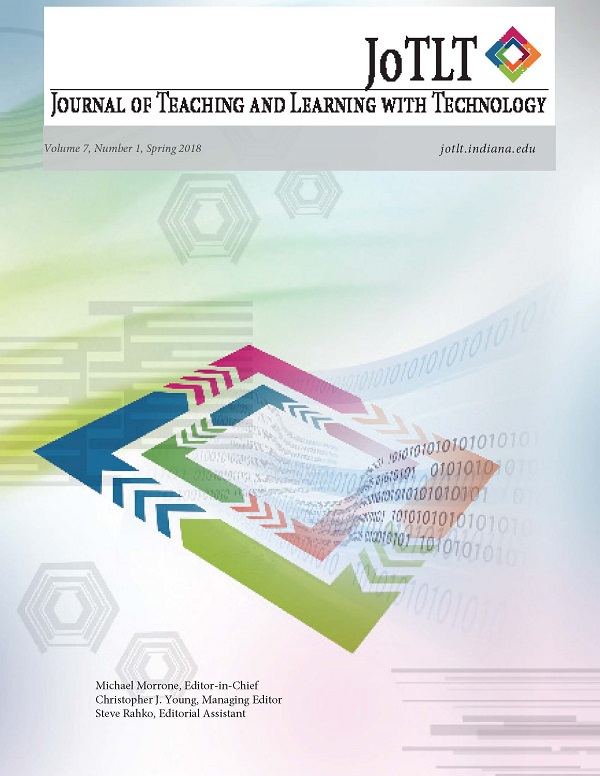Using the Photovoice Method to Elicit Authentic Learning in Online Discussions
Main Article Content
Abstract
While online discussions remain popular in college classrooms, mixed results persist about their effectiveness in eliciting authentic learning. This case study explores how students perceive the influence of the Photovoice method on their authentic learning, critical thinking, engagement, and peer interaction in an asynchronous online discussion. Photovoice is a research method combining photography with social action, in which people express their points of view by photographing scenes that highlight certain themes. Students in an online undergraduate course engaged in an online discussion which asked them to connect personal images to the course content. Students reported that this strategy supported authentic learning, critical thinking, engagement, and interaction; in addition, a correlational analysis found that these factors are highly interrelated. This case study proposes recommendations for practitioners interested in using a similar approach.
Downloads
Article Details
- Authors retain copyright and grant the Journal of Teaching and Learning with Technology (JoTLT) right of first publication with the work simultaneously licensed under a Creative Commons Attribution License, (CC-BY) 4.0 International, allowing others to share the work with proper acknowledgement and citation of the work's authorship and initial publication in JoTLT.
- Authors are able to enter separate, additional contractual agreements for the non-exclusive distribution of the journal's published version of the work (e.g., post it to an institutional repository or publish it in a book), with an acknowledgement of its initial publication in JoTLT.
- In pursuit of manuscripts of the highest quality, multiple opportunities for mentoring, and greater reach and citation of JoTLT publications, JoTLT encourages authors to share their drafts to seek feedback from relevant communities unless the manuscript is already under review or in the publication queue after being accepted. In other words, to be eligible for publication in JoTLT, manuscripts should not be shared publicly (e.g., online), while under review (after being initially submitted, or after being revised and resubmitted for reconsideration), or upon notice of acceptance and before publication. Once published, authors are strongly encouraged to share the published version widely, with an acknowledgement of its initial publication in JoTLT.
References
Ahearn, L. (2012). Living Language: An introduction to linguistic anthropology. Hoboken, NJ: Wiley-Blackwell.
Behar-Horenstein, L.S., & Niu, L. (2011). Teaching critical thinking skills in higher education: A review of the literature. Journal of College Teaching & Learning, 8(2), 25-41.
Blow, C. (2014). “Opinion: The Self(ie) Generation.” The New York Times. March 7.
Bonnycastle, M.M., & Bonnycastle, C.R. (2015). Photographs generate knowledge: Reflections on experiential learning in/outside the social work classroom. Journal of Teaching in Social Work, 35(3), 233-250.
Bonwell, C. C., & Eison, J. A. (1991). Active learning: Creating excitement in the classroom. uj(ASHEERIC Higher Education Report No. 1). George Washington University: Washington, D.C.
Chen, B., Seilhamer, R., Bennett, L., & Bauer, S. (2015). Students’ mobile learning practices in higher education: A multi-year study. EDUCAUSE Review. Retrieved on January 11, 2017, from http://er.educause.edu/articles/2015/6/students-mobile-learning-practices-in-higher-education-amultiyear-study
Cook, K. & Quigley, C. (2013). Connecting to our community: Utilizing photovoice as a pedagogical tool to connect college students to science. International Journal of Environmental and Science Education, 8(2), 339-357.
Dahlstrom, E. & Bichsel, J. (2014). ECAR study of undergraduate students and information technology, 2014. Research report. Louisville, CO: ECAR, October 2014.
deNoyelles, A., Zydney, J., & Chen, B. (2014). Strategies for creating a community of inquiry through online asynchronous discussions. MERLOT Journal of Online Teaching and Learning, 10(1), 153-165.
Edwards, M., Perry, B., Janzen, K., & Menzies, C. (2012). Using the artistic pedagogical technology of photovoice to promote interaction in the online post-secondary classroom: The students’ perspective. The Electronic Journal of e-Learning, 10(1), 32-43.
Fiorella, L., & Mayer, R.E. (2015). Learning as a generative activity: Eight learning strategies that promote understanding. New York: Cambridge University Press.
Gubrium, A.C., & Torres, M.I. (2013). The message in the bottle: Latino youth communicating double standard ideologies through photovoice. American Journal of Health Education, 44(3), 146-155.
Hew, K.F., Cheung, W.S., & Ng, C.S. (2010). Student contribution in asynchronous online discussion: a review of the research and empirical exploration. Instructional Science, 38, 571-606.
Jecklin, R. (2010). Online simulation of health care reform: Helping health educators learn and participate. Global Journal of Health Education and Promotion, 13(1), 90-99.
Johnson, G. (2011). A child’s right to participation: Photovoice as methodology for documenting experiences of children living in Kenyan orphanages. Visual Anthropology Review, 27(2), 141161.
Kroeger, S., & Meyer, H. (2005). Photovoice as an educational action research tool. Paper presented at the annual meeting of the American Educational Research Association, Montreal, Canada.
LaDonna, K., & Ravenek, M. (2014). Challenges and strategies for conducting qualitative research with persons diagnosed with rare movement disorders. The Qualitative Report, 19(16), 1-18.
Lombardi, M.M. (2007). Authentic learning for the 21st century: An overview. EDUCAUSE Learning Initiative Paper. Retrieved January 11, 2017 from https://net.educause.edu/ir/library/pdf/ELI3009.pdf
Mazzolini, M., & Maddison, M. (2007). When to jump in: the role of the instructor in online discussion forums. Computers & Education, 49(2), 193-213.
Schell, K., Ferguson, A., Hamoline, R., Shea, J., & Thomas-Maclean, R. (2009). Photovoice as a teaching tool: Learning by doing with visual methods. International Journal of Teaching and Learning in Higher Education, 21(3), 340-352.
Yang, Y., Newby, T., & Bill, R. (2005). Using Socratic questioning to promote critical thinking skills through asynchronous discussion forums in distance learning environments. The American Journal of Distance Education, 19(3), 163-181.
